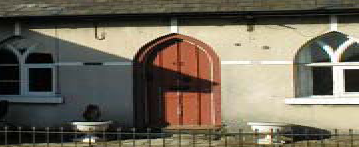


A
-
Seriously defective
Defective
Not satisfactory
Satisfactory/NA
HHSRS VERSION 2
COLLISION HAZARDS (Low Headroom)
Persons aged 16 years or over
None
A) Vertical section
Elec.
meter
&
fuses
i
Vulnerable age
Related hazards
Front elevation
Multiple locations
Yes
No
Secondary hazards
Yes
No
A) Plan
in
rear
v
yard
bath
living
bedrm
Cupboard
above i
^
in
front
yard
^ up
B) Front door
c.1880, Mid-terraced, former almshouse
A) Bedroom door
170 cm
door
living
hall
room
DESCRIPTION OF HAZARDS
Dwelling:
A)
B)
Internal doors: The internal doors leading from the small hall to the living room on the one side
and to the only bedroom on the other both have very low headrooms, the head of the frames being
only some 170 cm above the floor. The headroom on the living room door is made worse by a full
width cupboard immediately above the door, which projects around 30 cm and houses the
electricity meters and fuses. All other internal doors are of more or less normal height.
Front door: The frame to the front door is only approaching normal height (195 cm) in the very
centre of the door, the arches starting from a height of around 135 cm. The rear external kitchen
door is of normal height
LIST OF RELEVANT MATTERS
LIKELIHOOD & OUTCOMES
A
a
Door design defects
-
b
Disrepair to doors
-
c
Door closer defects
-
d
Door location
-
e
Window design defects
-
f
Disrepair to windows
-
g
Window location
-
h
Non-safety glass
-
I
Unprotected gaps
-
j
Low headroom to doors
3
k
Low beams and ceilings
-
# Secondary hazards
None
Key
3
2
1
-
Improved
A B C D E F G H
Average likelihood, outcomes and HHSRS score for Collision Hazards from Low
Headroom for all persons aged 16 years and over in all dwellings, 1997-99.
Score
HEALTH AND SAFETY RATING SYSTEM SCORES
Pre 1920 house
LIKELIHOOD
1 in
18
Low
High
Average: 180
Example
18
< 4200 2400 1300 750 420 240 130
75
42
24
13
7.5
4
2.5
1.5 >
Justification
OUTCOMES
Class I
Class II
Class III
Class IV
Justification
RATING
The likelihood of an occupant or visitor hitting their head on one of the three low doors
at least once over the year is almost a certainty, but that such an event will cause a
class I to IV harm is less likely. That said, because of the extent and position of the
faults, which includes the positioning of the electric meter cupboard immediately above
one of the doors, the likelihood of an occurrence resulting in such harm will still be
higher than the average for all dwellings.
%
Average: 0.0
0.0
< 0.05 0.15 0.3
0.7
1.5
3
7
15
26
38 >
Av: 0.5
1.0
< 0.05 0.15 0.3
0.7
1.5
3
7
15
26
38 >
Av: 7.0
10.0
< 0.05 0.15 0.3
0.7
1.5
3
7
15
26
38 >
Av: 92.5
89.0
< 0.05 0.15 0.3
0.7
1.5
3
7
15
26
38 >
43
0.0
1.0
10.0
89.0
A large proportion of entrapment and collision accidents involve trapping limbs or
fingers in doors and windows. However, as the main injury in this particular example is
almost certain to be to the head, the chances of suffering a severe or serious harm will
be somewhat higher than the general average for this category of hazard.
Example
A B C D E F G
Average: 20
H
I
J
271
Score
RATING SCORES AFTER IMPROVEMENT
IMPROVE
Justification
NEW RATING
Av: Nos
Likelihood to
1 in
100
Outcomes to
0.0
0.5 10.0 89.5 %
Increasing the height of the two internal door openings to 2 metres and re-siting the
electric meters can be reasonably easily achieved. To avoid destroying the character of
the almshouses, a warning signs could be used in the front door opening, given that this
is already higher than the internal doors. But, consequently, the risk would remain
higher than average.
Av: 20
I
J